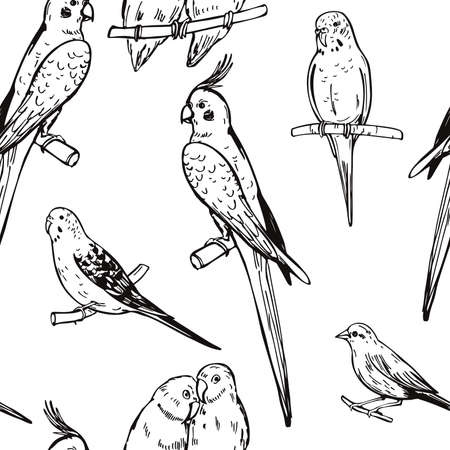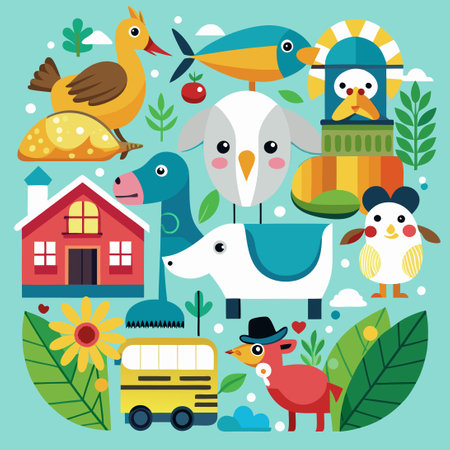Introduction to Avian Nutrition
When it comes to keeping our feathered friends happy and healthy, understanding their unique dietary needs is essential. Just like us, different bird species have distinct nutritional requirements that directly impact their health, energy levels, and even their lifespans. Whether you’re caring for backyard chickens, a chatty parrot in your living room, or wild songbirds visiting your garden feeders, knowing what fuels them best can make all the difference. In the United States, where birdkeeping is a cherished hobby and wild birds bring life to both rural and urban landscapes, providing the right nutrition isn’t just about preventing illness—it’s about helping these beautiful creatures thrive. By learning more about avian nutrition, we can ensure our birds enjoy vibrant feathers, strong immune systems, and long, joyful lives as beloved members of our homes or as welcome guests in our yards.
Seed Eaters versus Fruit and Nectar Lovers
When it comes to backyard birds, their dietary preferences can be as varied as their colors and songs. Understanding whether a bird is primarily a seed eater or prefers fruit and nectar is key to providing the right nutrition, especially for popular species like finches, parrots, and hummingbirds. Let’s explore how these differences influence their unique nutritional needs and daily feeding habits in American gardens and homes.
Dietary Preferences of Common Backyard Birds
| Bird Species | Main Diet | Nutritional Focus |
|---|---|---|
| Finches | Seeds (sunflower, millet, thistle) | High-energy fats, proteins, essential minerals |
| Parrots | Seeds, fruits, vegetables, nuts | Balanced vitamins, minerals, healthy fats |
| Hummingbirds | Nectar (flowers, feeders), insects | Sugars for energy, amino acids from insects |
The Seed Eaters: Finches and Parrots
Finches are classic seed eaters. Their strong beaks are made for cracking shells and accessing the nutrient-rich insides. In the wild or at your feeder, they thrive on sunflower seeds, nyjer (thistle), and millet. While seeds provide plenty of calories and healthy fats, a diet of only seeds can lack essential nutrients. Parrots also love seeds but benefit from a diverse menu that includes fresh fruits and leafy greens. Their inquisitive nature makes them open to sampling berries, apples (without seeds), carrots, and even cooked sweet potatoes—ensuring they get the vitamins and minerals needed for vibrant feathers and long-term health.
The Sweet Tooth: Hummingbirds
No American summer feels complete without the buzz of hummingbirds darting between flowers or hovering over feeders. These tiny wonders rely on flower nectar for quick energy from natural sugars. However, they also catch small insects for protein and other nutrients. If you’re setting up feeders, remember to use plain sugar water (never honey or artificial sweeteners) to mimic the natural nectar found in native flowers like trumpet vine or bee balm.
How Dietary Preferences Shape Nutritional Needs
The key takeaway for bird lovers is that each species’ diet shapes its nutritional requirements. Seed eaters need access to high-quality seed blends plus supplemental greens and veggies for balanced nutrition. Fruit-loving parrots require a rotation of safe fruits alongside grains and some nuts for variety. Nectar-loving hummingbirds depend on a steady supply of sugar water plus occasional protein boosts from flying insects. By catering to these different needs in your backyard or aviary, you support healthier birds—and get to enjoy all their lively personalities in return!

3. Protein and Supplements: Meeting Essential Needs
When caring for birds, especially in the diverse landscapes of American backyards and farms, its crucial to understand that protein plays a starring role in keeping our feathered friends healthy. Different bird species have varying requirements, but most need a consistent source of quality protein to support everything from vibrant plumage to active lifestyles. For insect-eating birds like bluebirds or chickadees, live insects such as mealworms or crickets are not just treats—they’re dietary essentials. Even backyard chickens benefit from occasional protein boosts through cooked eggs or dried insects, especially during molting season when their bodies work overtime to produce new feathers.
Beyond protein, supplements also make a big difference. Calcium is vital for egg-laying birds like hens and finches; it helps produce strong eggshells and supports bone health. Crushed oyster shells or cuttlebone are commonly offered in American coops and aviaries as reliable calcium sources. Vitamin supplements—either mixed into water or sprinkled over food—can help fill nutritional gaps, particularly during stressful times like breeding or cold snaps. Just remember, moderation is key: too much of anything can be harmful, so always follow recommended guidelines for your specific bird species.
By paying close attention to these essential nutrients and adjusting diets seasonally or according to life stages, bird lovers can ensure that their flocks stay energetic, resilient, and ready to brighten up any homestead or garden with their songs and antics.
4. Safe and Unsafe Foods for Birds
When sharing your rural home with a flock of feathered friends alongside dogs, cats, or even goats, it’s tempting to offer everyone a bite from the kitchen. However, not all human foods or plants are safe for birds, and what’s harmless to your pup may be toxic to your parakeet. Let’s explore which common foods and garden plants are suitable or hazardous for different bird species, so you can create a safe, happy environment for all your pets.
Common Human Foods: The Good and the Bad
| Food | Safe For | Unsafe For | Notes |
|---|---|---|---|
| Apple (no seeds) | Parrots, Finches, Canaries | None (seeds are toxic) | Remove all seeds before serving |
| Avocado | None | All bird species | Toxic compound called persin |
| Bread (plain, whole grain) | Sparingly for large parrots only | Small finches, budgies (filling but not nutritious) | Lacks nutrients; can cause obesity if overfed |
| Chocolate | None | All bird species | Theobromine is highly toxic to birds |
| Cooked Eggs (no seasoning) | Parrots, Chickens, Pigeons | Caution with tiny birds (portion size) | Good protein source in moderation |
| Coffee/Tea/Caffeinated Drinks | None | All bird species | Caffeine is dangerous for birds’ hearts and nervous systems |
| Grapes/Raisins | Larger parrots (sparingly) | Poultry, small songbirds (can cause kidney issues) | Sugar content high; watch portion size |
Garden Plants: What to Watch Out For in Rural Homes
| Plant Name | Toxic? | Affected Species & Notes |
|---|---|---|
| Pothos/Ivy/Vining Houseplants | Toxic | Poisons all pet birds if chewed on; keep out of reach indoors and outdoors. |
| Dandelion Greens (unsprayed) | Safe | Nutrient-rich treat for chickens, parrots, wild birds alike. |
| Lilies (all types) | Toxic | Lethal to cats and unsafe for birds—do not allow access in mixed homes. |
| Basil/Herbs (culinary varieties) | Safe in moderation | Savory treat for most birds; avoid moldy leaves. |
Mixing Bird Diets in Multi-Pet Homes: Safety Tips
- Avoid leaving bowls of people food accessible to curious birds—some foods that are fine for dogs or cats can be deadly to avians.
- If you’re growing vegetables or herbs outside, make sure they haven’t been treated with pesticides before offering them as treats.
- Create “bird-safe zones” where no potentially harmful foods or plants are within pecking distance.
A Note on Wild Bird Visitors in Rural Areas:
If you feed wild birds near your home, remember their nutritional needs differ from pet birds. Offer native seeds and suet rather than bread or processed snacks. This helps keep both visiting wildlife and resident pets healthy while maintaining the peace and harmony of rural life with multiple animal companions.
5. Feeding Tips for Multi-Bird Households
Sharing your home with a flock of different bird species is incredibly rewarding, but it also brings unique challenges—especially when it comes to nutrition. Each bird has its own dietary preferences and needs, so managing mealtimes in a multi-bird household requires thoughtful planning. Here are some practical tips to keep your feathered family healthy and happy.
Understand Species-Specific Needs
The first step is knowing exactly what each species requires. Parrots, finches, canaries, cockatiels, and doves all have different nutritional needs—ranging from protein content to vitamin requirements. Take time to research or consult an avian vet for each species you care for. This ensures you’re not unintentionally depriving any bird of essential nutrients.
Set Up Separate Feeding Areas
To prevent competition and accidental food swapping, create designated feeding zones for each species. Use separate dishes or feeders in different parts of your home or aviary. This helps reduce stress at mealtime and ensures every bird gets the right food for their needs. For birds that require special diets (like a lory’s nectar), keep their meals well away from seed-eating species.
Establish Consistent Feeding Schedules
Birds thrive on routine, so set regular feeding times that work for your household. Morning and early evening are popular choices among American bird lovers, as they mimic natural feeding rhythms in the wild. A predictable schedule helps birds feel secure—and makes it easier for you to monitor everyone’s appetite and health.
Monitor Food Intake and Behavior
Keep an eye on how much each bird eats and watch for changes in behavior around feeding time. Some birds may try to “sample” foods not meant for them, while others might be too shy to approach their dish if a larger or more dominant bird is nearby. Adjust feeder locations as needed to ensure peace at mealtimes.
Encourage Foraging and Enrichment
Diverse households benefit from enrichment activities like hiding healthy treats or using puzzle feeders tailored to each species’ abilities. This keeps mealtime interesting and allows birds to eat at their own pace—reducing the risk of food guarding or bullying.
Stay Flexible and Observant
Your birds’ needs may change over time due to age, health, or flock dynamics. Be ready to tweak diets, feeder placement, or schedules as needed. By staying attentive and proactive, you’ll foster a peaceful, healthy environment where every member of your avian family can thrive.
6. Seasonal and Life Stage Considerations
Much like the changing rhythms of life on an American homestead, a bird’s dietary needs shift with the seasons and throughout their life stages. Whether you’re caring for backyard chickens in rural Georgia, raising parrots in a cozy Midwest farmhouse, or watching wild songbirds flit between your Vermont apple trees, understanding these changes is key to keeping your feathered friends happy and healthy.
Adapting Diets Through the Seasons
As temperatures dip or soar, birds require different nutrients to thrive. In colder climates—think snowy winters in Montana or chilly mornings in upstate New York—birds benefit from higher-fat feeds like black oil sunflower seeds or suet cakes. These energy-rich foods help them maintain body heat and stamina. Come spring and summer, when natural food sources are abundant and birds are more active, lighter fare such as fruits, insects, and grains become ideal. For those living in the American South or Southwest, where summers can be brutally hot, offering fresh water daily and hydrating foods like melon or cucumber slices is crucial for flock health.
Life Stage Nutrition: Chicks, Adults, Molting & Breeding Birds
The nutritional needs of birds also change dramatically as they grow and take on new roles within their flock or family. Chicks need starter feed high in protein to support rapid growth—just like a playful puppy needs more calories than an old farm dog dozing on the porch. As birds mature, adult maintenance diets with balanced grains and greens keep them strong. During molting season—a time when birds shed old feathers for new—extra protein supports healthy feather regrowth. And if you have laying hens or breeding pairs, they’ll need additional calcium (think crushed oyster shells) to produce strong eggshells and sustain healthy chicks.
Tips for Rural Bird Lovers
For those of us living the country life, sourcing seasonal treats from your own land is both practical and rewarding. Scatter scratch grains in winter for wild turkeys or offer mealworms during molting time to give your backyard bluebirds a boost. Rotate garden scraps based on what’s fresh—pumpkin seeds in fall, leafy greens in spring—to supplement store-bought feeds. By tuning into the natural cycles around you and adjusting diets accordingly, you’ll help every bird under your care thrive through all of life’s chapters and all four seasons.
7. Conclusion: Happy, Healthy Flock
Understanding the nutritional needs of different bird species is more than just a science—it’s a heartfelt commitment to the happiness and wellbeing of your feathered friends. Mindful, species-specific feeding ensures that each bird, whether a chirpy canary, majestic parrot, or charming backyard finch, receives the nutrients they need to thrive. When you tailor diets to their unique requirements, you’re not only supporting vibrant plumage and energetic personalities but also reducing health risks in your flock. The joy of caring for a diverse avian community extends beyond the daily routines; it’s about watching birds flourish under your care and knowing you’re providing the best life possible. There’s a special satisfaction in seeing your flock come together—a symphony of colors and songs—reflecting the benefits of attentive nutrition. By embracing this thoughtful approach, you foster a healthy environment where every bird feels at home, rewarding you with companionship, beauty, and endless inspiration straight from your own little slice of paradise.


